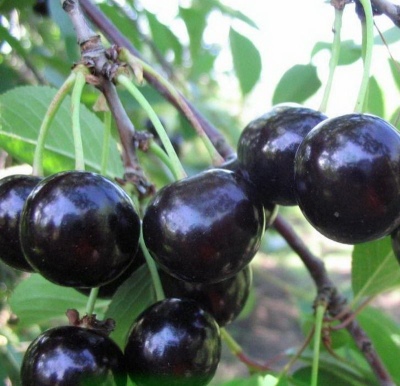
- Fruit shape: rounded-oval, flattened from the sides
- Authors: Rossoshan Experimental Gardening Station
- Growth type: vigorous
- Appointment: universal
- Yield: high
- Tree height, m: 4
- Crown: pyramidal, medium density
- Fruit size: large
- Fruit weight, g: 6,7
- Fruit color: maroon
The successful work of domestic breeders helps to promote traditionally southern crops to regions with more severe climatic conditions. A typical example of such achievements is the Rossoshanskaya large cherry. The first name indicates the place of origin - it is the Rossoshan experimental station, located in the Voronezh region. The second definition in the name of the variety did not appear by chance - three pearls of domestic selection were bred at once: black, gold and large.
Breeding history
It is not known why Rossoshanskaya large, like other developments of the breeder A. Ya. Voronchikhina at the experimental station in the vicinity of Voronezh, were not included in the State Register. This circumstance does not affect the popularity of each of the three known varieties. They are in demand and are successfully grown in the southern regions of Russia and on the territory of Ukraine. The origin of the varieties is from the Central Black Earth region, and this proves that the scope of successful breeding developments can be much wider than limited by traditions.
Description of the variety
The main advantages are invariably mentioned - large-fruited, unpretentious care, the ability to grow in small areas due to small (up to 4 m) growth, a pyramidal crown, branches of medium density. It blooms with large white flowers, giving the site a decorative effect, but this is not the main, but an additional argument in its description.
Fruit characteristics
The large Rossoshanskaya has unusually large berries, 6.7 grams, with a unique taste and a small bone that can be easily separated from the dense pulp. For those who are engaged in breeding for the purpose of obtaining commercial profit, there is an additional bonus - the berries perfectly tolerate transportation and retain their presentable appearance for a long time. In addition, they have a universal purpose and are suitable for eating fresh and for any culinary needs - from baking to preparations for the winter.
Taste qualities
The tasting score is 4.5 points, but the opinion of sweet cherry lovers speaks of an insufficient assessment of the unique characteristics of the variety. The berries are easily separated from the stalk, as already mentioned, they can reach almost 7 grams, are very aromatic and give a pleasant aftertaste. A little sourness in the sweet, dense pulp splashing with juice only adds sophistication to baked goods, compotes, preserves and jams. The rich maroon shade of the berry, slightly flattened from the sides, remains after heat treatment, and the presence of valuable components - vitamins and minerals - makes it in demand in summer and winter.
Ripening and fruiting
It is considered a medium ripening variety, which makes it the best option for making a profit. At this time, there are practically no competitive proposals for sweet cherries on the market, but the demand is still high.

Yield
The average yield is 100 c / ha, but with proper care it can give a gardener even more.A separate argument in favor of choosing a variety can be the ability to withstand adverse weather conditions - cold spring and dry summer. At the same time, neither the presentability of the harvested and transported crop nor its quantity changes. In the correct storage conditions it can be stored for quite a long time without losing its taste and aroma.
Growing regions
It has proven itself perfectly in the south, in the Central Black Earth Region and in the North Caucasus region. This means that gardeners in choosing a variety can be guided by similar climatic conditions to obtain a generous harvest with excellent taste. Partial self-fertility and the need for cross-pollination make it possible to start mass cultivation next to other varieties of sweet and sour cherries or in a separate area with the simultaneous planting of several seedlings of this species.
Growing and care
It is recommended to plant in a southern direction, in places reliably protected from cold air currents, with good lighting. Of the soils, sandy loam or loam is preferable, but the soil can be refined, but the timing of flowering of nearby cherries or sweet cherries should coincide with a similar period.
The care includes the usual procedures - the application of fertilizers in the fourth year (until this moment there are enough laid in the pit for planting). Watering, loosening the soil after natural precipitation, spring pruning of branches, removing autumn debris so that pests do not winter.
A list of care measures is given, speaking of the unpretentiousness of a beautiful culture with large berries of a beautiful color, a piquant taste and delicious aroma, the ability to maintain its properties during storage and moving to retail outlets.





































































